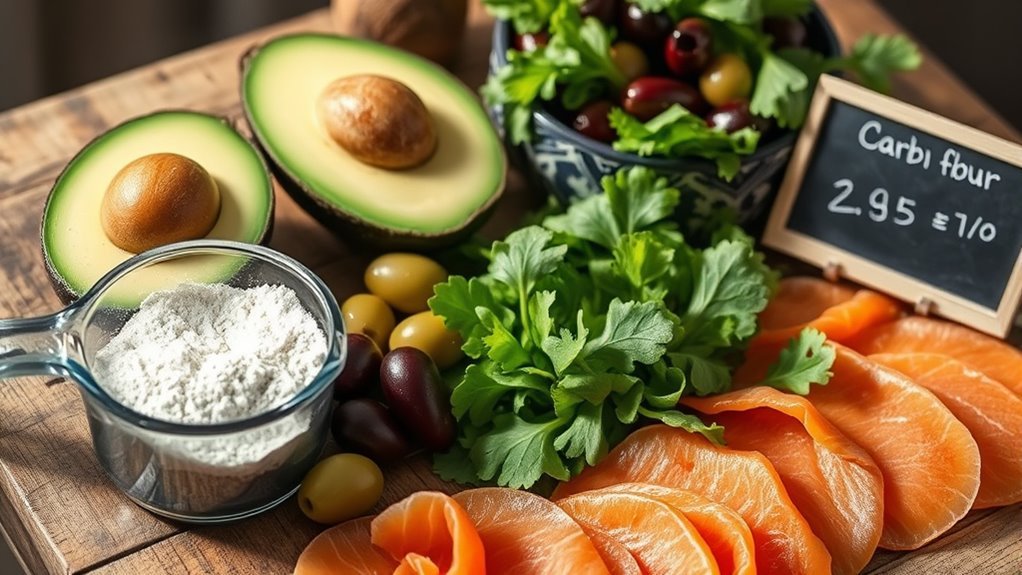To achieve and maintain ketosis, you should limit your daily carbohydrate intake to between 20 to 50 grams. This means focusing on non-starchy vegetables and healthy fats while avoiding grains, sugars, and most fruits. By doing so, you’ll enhance fat metabolism and promote ketone production. It’s crucial to understand how to track your intake and adjust it based on your individual needs for best results. Continue exploring to discover more tips on steering your keto journey.
Understanding Ketosis and Carbohydrates

Understanding ketosis and carbohydrates is essential for anyone considering a ketogenic diet. The ketosis process involves your body shifting from burning glucose for energy to utilizing fat, which can lead to weight loss and improved energy levels. To achieve this state, you need to markedly reduce carbohydrate sources in your diet, typically to about 20-50 grams per day. Common carbohydrate sources like bread, pasta, and sugary foods can hinder your ability to enter ketosis, so you’ll want to replace them with low-carb options such as leafy greens, nuts, and healthy fats. By limiting carbs, you encourage your body to produce ketones, enhancing fat metabolism and supporting your journey toward greater dietary freedom.
The Standard Ketogenic Diet (SKD) Guidelines

The Standard Ketogenic Diet (SKD) sets specific guidelines for daily carbohydrate intake, typically limiting it to about 20 to 50 grams. This restriction is vital for achieving and maintaining ketosis, which is essential for the diet’s effectiveness. Additionally, understanding which foods fit within these guidelines is key to successfully following the SKD.
Daily Carb Limit
For those following the Standard Ketogenic Diet (SKD), keeping your daily carb intake between 20 to 50 grams is essential for achieving and maintaining ketosis. This range allows you to effectively utilize fat for fuel instead of carbohydrates.
Implementing carb timing strategies can further enhance your results. By consuming your carbs around workouts, you can maximize energy and minimize fat storage. Focus on quality keto carb sources such as non-starchy vegetables and nuts.
| Carb Timing Strategies | Keto Carb Sources |
|---|---|
| Pre-Workout | Leafy greens |
| Post-Workout | Berries |
| Throughout the Day | Avocados, nuts, seeds |
Sticking to these guidelines helps you maintain the freedom to enjoy your keto journey.
Food Choices Allowed
While following the Standard Ketogenic Diet (SKD), it is crucial to select food choices that align with your goal of achieving ketosis. Focus on high-fat, moderate-protein, and low-carb foods. Incorporate plenty of green, leafy vegetables, fatty fish, eggs, and healthy oils like olive and coconut oil. For your meal planning, include keto friendly snacks such as nuts, cheese, or avocado to keep your energy levels stable and cravings at bay. Avoid grains, sugars, and most fruits to maintain your carb limit. Remember, the right food choices not only support ketosis but also promote overall well-being, allowing you the freedom to enjoy delicious meals while achieving your health goals. Stay mindful of your portions to optimize results.
Carb Intake Recommendations for Different Individuals

Understanding carb intake recommendations is essential, especially since individual needs can vary greatly based on factors such as age, activity level, and health goals. To find your ideal carb intake, you should consider your individual carb thresholds, which may differ considerably from someone else’s. For instance, athletes or highly active individuals might tolerate higher carb levels compared to those with sedentary lifestyles. Creating personalized diet plans will help you determine how many carbs you can include while still achieving ketosis. Generally, most people aim for 20 to 50 grams of net carbs daily, but experimenting within this range can guide you to what feels right for your body. Always listen to your body’s signals as you adjust your intake.
Types of Carbohydrates: Net Carbs vs. Total Carbs
When following a keto diet, it’s essential to understand the distinction between net carbs and total carbs. Net carbs are calculated by subtracting fiber and certain sugar alcohols from total carbohydrates, as they have minimal impact on blood sugar levels. This knowledge can help you make informed choices about your carb intake and maintain ketosis effectively.
Understanding Net Carbs
Carbohydrates can be confusing, especially when distinguishing between net carbs and total carbs, which is essential for those following a ketogenic diet. Understanding net carbs is crucial since it gives you a clearer picture of how carbs impact your body. Net carbs are calculated by subtracting fiber content from the total carbs in a food. Fiber doesn’t spike your blood sugar, making it less relevant for keto.
Here’s what to remember about net carbs:
- Focus on digestible carbs that affect blood sugar.
- Fiber content can be subtracted, as it’s not fully absorbed.
- Many keto-friendly foods are high in fiber.
- Tracking net carbs helps maintain ketosis.
Total Carbs Explained
To effectively manage your carbohydrate intake on a ketogenic diet, it’s important to differentiate between total carbs and net carbs. Total carbs refer to the complete amount of carbohydrates in a food item, including fiber and sugars, while net carbs are calculated by subtracting fiber and certain sugar alcohols from the total. Understanding this distinction helps you evaluate carb sources more accurately. For instance, non-starchy vegetables and nuts may have high total carbs, but their fiber content reduces their net carbs considerably. By focusing on net carbs, you can enjoy a wider variety of foods while staying within your carb limits. Ultimately, knowing how to assess total carbs versus net carbs empowers you to make informed choices on your keto journey.
How to Track Your Carb Intake Effectively
While many people find the ketogenic diet effective for weight loss and improved energy levels, tracking your carb intake is essential to guarantee you stay within your daily limits. Here are some effective methods to track your carbs:
- Use smartphone apps for convenient tracking on the go.
- Maintain a food diary to log everything you eat.
- Pay attention to nutrition labels for accurate carb counts.
- Involve accountability partners for support and progress monitoring.
Common Keto-Friendly Foods and Their Carb Content
Knowing how to track your carb intake is just the first step in successfully following a ketogenic diet. Incorporating keto snacks like cheese crisps or beef jerky can satisfy cravings without adding too many carbs. Focus on high fiber vegetables such as spinach and broccoli, and opt for low carb fruits like berries. Dairy options, including full-fat yogurt and cream, also fit into your meal prep. When snacking, consider nut varieties like almonds or walnuts for healthy fats. For protein sources, choose meats, eggs, and fish. Dining out? Look for ingredient substitutions, like lettuce wraps instead of bread. Finally, don’t forget about keto desserts made with almond flour or coconut flour to satisfy your sweet tooth without derailing your diet.
Adjusting Carb Intake for Weight Loss and Maintenance
Adjusting your carb intake is essential for effective weight loss and maintenance on a ketogenic diet. To optimize your approach, consider the following strategies:
- Monitor your carb intake: Track your daily consumption to identify what works best for you.
- Incorporate carb cycling: Alternating high and low-carb days can help prevent metabolic adaptation, keeping your metabolism efficient.
- Be mindful of portion sizes: Even keto-friendly foods can contribute to weight gain if consumed excessively.
- Stay flexible: Adjust your carb intake based on your goals; you might need fewer carbs for weight loss and slightly more for maintenance.
Potential Challenges With Carb Restrictions on Keto
Although many people find success with a ketogenic diet, carb restrictions can present several challenges that may hinder progress. Social situations often tempt you with carb-laden foods, making cravings management essential. Without careful meal planning, you might face nutrient deficiencies, impacting your energy levels and overall health. The rigidity of dietary restrictions can also reduce your dietary flexibility, leading to frustration. Additionally, the psychological effects of constant deprivation might challenge your motivation strategies, making it harder to stick with your goals. To navigate these potential pitfalls, focus on finding satisfying low-carb alternatives, seek support from others, and allow for occasional indulgences to maintain balance and enjoyment in your keto journey.


